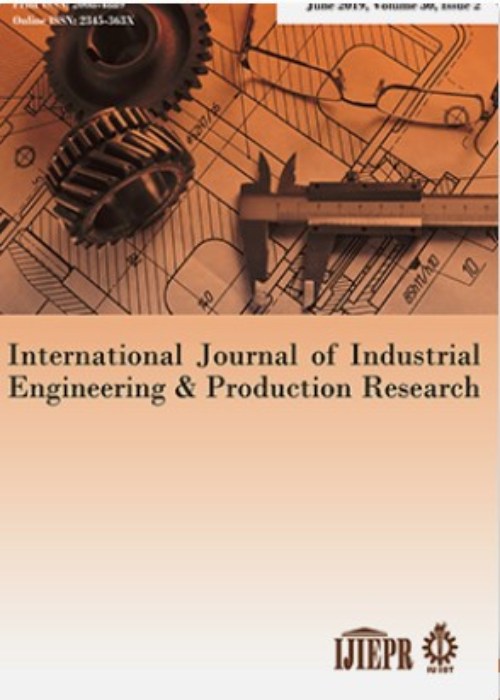فهرست مطالب
International Journal of Industrial Engineering and Productional Research
Volume:18 Issue: 4, Dec 2007
- تاریخ انتشار: 1378/09/17
- تعداد عناوین: 5
-
-
Page 39The meshless local Petrov-Galerkin method with unity as the weighting function has been applied to the solution of the Navier-Stokes and energy equations. The Navier-Stokes equations in terms of the stream function and vorticity formulation together with the energy equation are solved for a driven cavity flow for moderate Reynolds numbers using different point distributions. The L2-norm of the error as a function of the size of the control volumes is presented for different cases; and the rate of convergence of the method is established. The results of this study show that the proposed method is applicable in solving a variety of non-isothermal fluid flow problems.
-
Page 47The effect of a bond failure and its extent is studied on stress concentration in long fibers as well as stress distribution in short fibers and their surrounding matrix bays. The material is assumed to be a finite width hybrid composite lamina which is subjected to a tensile load of magnitude "P" at infinity. The surrounding matrix is assumed to take only shear (shear-lag theory). The bay adjacent to the first intact filament is allowed to experience a bond failure of size 2d. This failure is due to excessive shear load in the matrix which exceeds the fiber-matrix bond strength. The matrix at this zone may or may not experience yielding. The short fibers are simulated by assuming two successive breaks along each filament. The effect of bond failure length on short fiber load bearing capability, as well as stress concentration in the first intact filament is fully investigated. The effect of hybridization, in presence of bond failure is also examined on short fiber load bearing behavior.
-
Page 59The governing equations of motion for a drill string considering coupling between axial, lateral and torsional vibrations are obtained using a Lagrangian approach. The result leads to a set of non-linear equations with time varying coefficients. A fully coupled model for axial, lateral, and torsional vibrations of drill strings is presented. The bit/formation interactions are assumed to be related to the following parameters: bit motion, effects of gyroscopic moments, contact with the borehole wall, axial excitation due to bit/formation interactions, and hydrodynamic damping due to the presence of drilling mud. Simulation results show that parametric resonance and whirling may occur simultaneously within the range of operating conditions of drilling. The contact force between collar and borehole wall is calculated and its behavior is investigated. The dynamic behavior is quite complicated and may become non-periodic, suggesting a chaotic behavior.
-
Page 67This paper presents the results of experimental determination of fiber bed permeability variation with porosity. Flow measurement experiments were designed to measure fiber mat permeability for fiber beds with various fiber volume fractions. Woven fiberglass, chopped fiberglass, and carbon fiber mats were used as reinforcements. The effects of reinforcement type and porosity on fiber bed permeability were investigated. Fiber mat permeability of woven mats showed large degrees of anisotropy, whereas chopped fiberglass mats had isotropic permeability. In all cases perform permeability increased with fiber bed porosity. Fiber mat permeability of woven carbon was found to be about four times lower than that of woven fiberglass mats at the same porosity. This lower permeability results in longer injection time and higher manufacturing cost for composite parts made with carbon fiber mats. The results of this investigation could be employed in process/product optimization in Resin Transfer Molding (RTM) processes.
-
Page 75This paper presents the results of an experimental examination of the effect of non-uniform wall temperature on local heat transfer coefficient in a rotating smooth-walled square channel. Three different thermal boundary situations were investigated: (a) even and odd (four) wall uniform temperature, (b) even and odd (four) wall uniform heat flux, and (c) even (leading and trailing) walls hot with two side walls kept cold. It is demonstrated that the local heat transfer coefficients on the trailing edge are much higher than that of the leading edge. For situation (a) of even (leading and trailing) walls with two sides uniform temperature, the leading edge heat transfer coefficient decreases and then increases with increasing rotational numbers. And the trailing edge heat transfer coefficient increases monotonically with rotational numbers increasing. However, the trailing edge as well as the side walls heat transfer coefficient for situation (b) is higher than situation (a) and the leading edge local heat transfer coefficients for situations (b) and (c) are significantly higher than situation (a). The obtained results suggest that the local non-uniform wall temperature creates the local buoyancy force that diminishes the effect of the Coriolis force. Consequently, the local heat transfer coefficients on leading, trailing, and side edges are affected by the wall non-uniform temperature.


